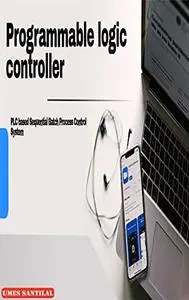Programmable logic controller: PLC based Sequential Batch Process Control System by umes santilal
English | 2020 | ISBN: N/A | ASIN: B0875SD82K | 290 pages | EPUB | 1.38 Mb
English | 2020 | ISBN: N/A | ASIN: B0875SD82K | 290 pages | EPUB | 1.38 Mb
PLC originated in the late 1960s in the automotive industry in the USA and were designed to replace relay logic systems.[1] Before, control logic for manufacturing was mainly composed of relays, cam timers, drum sequencers, and dedicated closed-loop controllers.The hard-wired nature made it difficult for design engineers to alter the process. Changes would require rewiring and careful updating of the documentation. If even one wire were out of place, or one relay failed, the whole system would become faulty. Often times technicians would spend hours troubleshooting by examining the schematics and comparing them to existing wiring.[2] When general-purpose computers became available, they were soon applied to control sequential and combinatorial logic in industrial processes.[citation needed] These early computers required specialist programmers and strict control of working conditions, such as temperature, cleanliness, and power quality.[citation needed]The PLC was developed with several advantages over earlier designs. It tolerated the industrial environment better than computers and was more reliable, compact and required less maintenance than relay systems. It was easily extensible with additional I/O modules, while relay systems required complicated hardware changes in case of reconfiguration. This allowed for easier iteration over manufacturing process design. Comparing to a computer, PLC in a rack format can be more easily extended with additional I/O in the form of I/O cards. With simple programming language focused on logic and switching operations it was more user-friendly than computers using general-purpose programming languages. It also permitted for its operation to be monitored.[1][3]Early PLCs were programmed in ladder logic, which strongly resembled a schematic diagram of relay logic. This program notation was chosen to reduce training demands for the existing technicians. Other PLCs used a form of instruction list programming, based on a stack-based logic solver.[citation needed]ModiconIn 1968, GM Hydramatic (the automatic transmission division of General Motors) issued a request for proposals for an electronic replacement for hard-wired relay systems based on a white paper written by engineer Edward R. Clark. The winning proposal came from Bedford Associates from Bedford, Massachusetts. The result was the first PLC—built in 1969–designated the 084, because it was Bedford Associates' eighty-fourth project.[4][5]Bedford Associates started a company dedicated to developing, manufacturing, selling, and servicing this new product: Modicon, which stood for modular digital controller. One of the people who worked on that project was Dick Morley, who is considered to be the "father" of the PLC.[6] The Modicon brand was sold in 1977 to Gould Electronics and later to Schneider Electric, the current owner.[5]One of the very first 084 models built is now on display at Schneider Electric's facility in North Andover, Massachusetts. It was presented to Modicon by GM, when the unit was retired after nearly twenty years of uninterrupted service. Modicon used the 84 moniker at the end of its product range until the 984 made its appearance.[citation needed]Allen-BradleyIn a parallel development Odo Josef Struger is sometimes known as the "father of the programmable logic controller" as well.[6] He was involved in the invention of the Allen‑Bradley programmable logic controller during 1958 to 1960[7][8][9] and is credited with inventing the PLC acronym.[6][7] Allen-Bradley (now a brand owned by Rockwell Automation) became a major PLC manufacturer in the United States during his tenure.[10] Struger played a leadership role in developing IEC 61131-3 PLC programming language standards.
Feel Free to contact me for book requests, informations or feedbacks.
Without You And Your Support We Can’t Continue
Thanks For Buying Premium From My Links For Support
Without You And Your Support We Can’t Continue
Thanks For Buying Premium From My Links For Support



